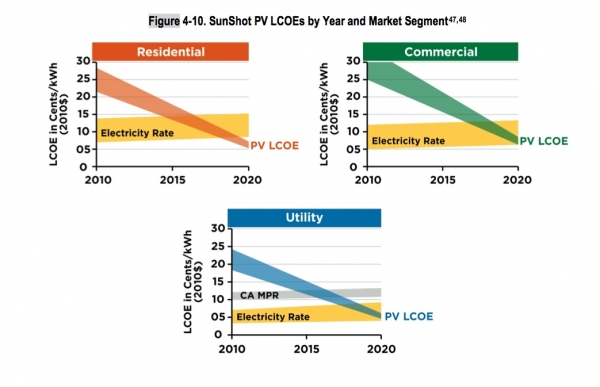|
|
|
|
|
Minh Le: 'The Stone Age ended because we had a better solution and solar is certainly one of those better solutions.' |
Critics complained that Solyndra's collapse finally proved that government should not be in the business of picking winners. But the Department of Energy's solar programme has been doing just that with remarkable success.
|
|
|
Levelised cost of energy from achieving SunShot system prices calculated using assumptions about O&M expenses, inverter efficiencies and derate factors (due to losses in wiring, diodes or shading). |
Minh Le has been the director of the DoE's solar technology programme since November last year, after three years as acting manager and chief engineer.
"Fifteen years ago when the only thing out there was silicon, the DoE invested in a new technology called cadmium telluride which started out of the National Renewable Energy Laboratory and eventually became First Solar,” he says in an interview with PV Tech.
"We have a long history in leading the world in innovative ideas. More than half of the world records over 35 years for solar cell efficiencies were funded out of the solar programme at the DoE."
It's an impressive record for the DoE. Last week's announcement at Solar Power International in Chicago of US$60 million in the SunShot Initiative brings the total invested in the DoE's incubator programme to US$828 million since 2007. Fifty-eight startup companies have received a total of 71 awards to develop photovoltaic technologies, concentrating solar power (CSP) technologies, power electronics, balance-of-system (BOS) hardware and non-hardware soft costs.
The DoE has awarded approximately US$16 million to four projects that will help develop solar devices near the theoretical efficiency limits of single junction solar cells – about 30% efficiency. The department has also awarded about US$7 million to develop stronger, more reliable solar components as well as performance tests for micro-inverters and micro-converters.
But since PV panel costs have declined so dramatically by US$2.1/Watt between 2008 and 2011, soft costs for balance of systems have become an increasing area of focus as they now account for 62% of the costs of residential systems.
The DoE's Solar Rooftop Challenge programme brought some notable successes in reducing these soft costs. Broward County in Florida has now implemented an online permitting process that could take as little as 30 minutes to complete. Massachusetts has seen a 20% cost reduction in residential solar through a group buying programme.
"These are significant wins," Le says. "Overall, across 22 different participants we saw on average a reduction in time to permit commercial or residential systems by one week.
"That may not seem like a lot of time, but when you add it up across the 40,000 systems installed in those territories, that's 800 person-years of red tape saved. That's like saving lives, we're saving lives in terms of bureaucracy."
Cooperation between regional authorities to make red tape such as permitting and interconnection more consistent across the 18,000 municipalities in the US will also reduce costs, Le says.
"Small and large businesses need to operate across larger areas to get economies of scale," he says. "Businesses now have to employ more people who understand the very different permitting and business processes in these different towns. We want state and local governments, city and municipalities to work together in their regions to arrive at common processes."
One metric of success for the SunShot Initiative is the private capital that has followed on from DoE investment. Since 2007, US$104 million in government funds has attracted more than US$1.7 billion in venture capital and private equity, a ratio of nearly US$18 in private sector support for every US$1 of federal support.
"What's really exciting about this programme is that some of these companies are doing tremendously. Multiple examples just in the past year of companies that were acquired like Tetrasun an early awardee from our incubator programme and acquired by First Solar."
However, the SunShot Initiative does not just invest in technologies, but business models such as Clean Power Finance, which has developed an online "marketplace" to connect solar businesses in distributed generation with institutional solar finance investors.
Mosaic, which has raised US$3.8 million so far through its crowd-funding model, is also an awardee. EnergySage aims to become the Amazon of solar distributed generation with its online marketplace allowing for multiple bids in residential solar systems. Qubotix, a company that has developed a robotic installation system, is now getting field deployment.
"Some of these companies we make investments [in] when there's two people," says Le. "Sometimes it takes time to mature but some of these companies are growing very rapidly so I'm really excited what I see in our portfolio."
Since 2011, SunShot's ultimate goal has been to reduce the cost of utility-scale solar to US$1/Watt by 2020.
Le says that from data collected by DoE, the industry is well on track to achieve its "giant leap" target set by former energy secretary Steven Chu and triggered by President Barack Obama's invocation of John F Kennedy's "moonshot".
"Chu challenged us to think about how to unlock American innovation and ingenuity to reduce that cost to the point where it's competitive with conventional forms of energy generation without subsidies by the end of the decade. That would be around 6c per kWh, the cost of wholesale electricity.
"When we were planning for the SunShot Initiative back in 2010 the price of utility-scale PV power plants was around US$3.40-3.80/W. To get to that cost parity would mean roughly a 75% reduction in price from the 2010 baseline; that would mean US$1/W for utility scale."
Commercial and residential targets are slightly higher, at US$1.25/W and residential about US$1.50/W respectively, Le says.
"These are very aggressive targets but look at where we've come just in the past several years. By the end of 2012 the average price we were tracking for utility power plants was somewhere around US$2.25/W. In 2013, I hear reports of utility-scale systems below US$2/W. In the past two to three years, we've fallen from US$3.50-$4/W down to less than US$2. We have US$1/W to go.
"Of course, the first couple of dollars are the easiest to reduce so I don't want to diminish the challenge that lies ahead. But we're well on target especially at the utility scale to reduce these costs to the point where it is broadly competitive.”
Last year's ‘SunShot Vision’ report found that achieving the level of price reductions envisioned in the SunShot Initiative could result in solar energy meeting 14% of US electricity needs by 2030 and 27% by 2050.
"However, realising these price and installation targets will require a combination of evolutionary and revolutionary technological changes," it noted.
It would also require vast amounts of capital, with cumulative investments estimated at roughly US$25 billion through 2030 and US$44 billion through 2050.
In his speech to SPI last week, Le spoke at length about the need for action on climate change, a controversial energy topic in the US dogged by political resistance. Le later told PV Tech that he feels so confident talking about solar as a tool to tackle climate change because of the role of the United States as a global leader.
"Emerging nations such as China and India, their citizens are going to want what we've enjoyed in the western world for many decades, all the luxuries of electricity and the advantages that electricity brings about to health, education and the economy," he says.
"There are many more billions of people in those countries and if they increase their carbon footprint by 10% that's going to be a tremendous toll on the environment. What's important is for the US to lead. The rest of the world will not do the tough and necessary steps in order to mitigate against climate change unless the US leads.
"Solar is an important part of that. The Stone Age did not end because we ran out of stones. The Stone Age ended because we had a better solution and solar is certainly one of those better solutions."
Email this page to a friend




